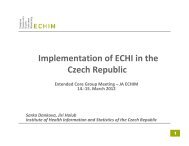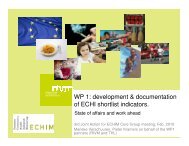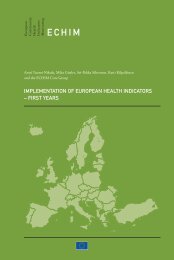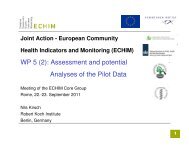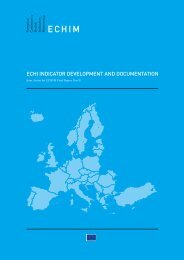INDICATORS
ECHIM Final Report
ECHIM Final Report
You also want an ePaper? Increase the reach of your titles
YUMPU automatically turns print PDFs into web optimized ePapers that Google loves.
23. DEPRESSION<br />
Definition: Proportion of persons who have had episode(s) of major depression during the<br />
past 12 months. Major depression is a mental disorder characterised by sustained depression<br />
of mood, anhedonia, sleep and appetite disturbances, and feelings of worthlessness, guilt,<br />
and hopelessness.<br />
Calculation:<br />
1) Proportion of individuals reporting to have been diagnosed with chronic depression which<br />
occurred during the past 12 months, per 100 000 survey population, derived from EHIS<br />
questions HS.4/5/6: HS.4: Do you have or have you ever had any of the following diseases<br />
or conditions? (19. Chronic depression) (yes / no). If yes: HS.5: Was this disease/condition<br />
diagnosed by a medical doctor? (yes / no). HS.6: Have you had this disease/condition in the<br />
past 12 months? (yes / no).<br />
2) Recommendation by Mindful/Working Party Mental Health: Age and sex adjusted<br />
prevalence of cases fulfilling the criteria of major depression for at least two weeks during<br />
past 12 months. Instrument to be used is The World Health Organisation Composite<br />
International Diagnostic Interview Short Form, CIDI-SF. Diagnostic criteria for a major<br />
depressive episode (MD; DSM-IV) include a depressed mood, a marked reduction of<br />
interest or pleasure in virtually all activities, or both, lasting for at least 2 weeks. In addition,<br />
the following 7 further questions are asked: losing interest, feeling tired, change in weight,<br />
difficulty sleeping, trouble concentrating, feeling down, and thoughts about death (present<br />
and lasting for at least 2 weeks). The respondent’s score is then calculated as the sum of<br />
positive responses to these additional seven questions (range 0–7). The cut-off point for a<br />
major depressive episode is 3, in the range of 0 to 7.<br />
3) EPIC Elderly NAH recommendation: Self-perceived depression for people 60+ years of<br />
age. Calculated as the number of persons who reported major depression divided by total<br />
target population x 100.<br />
ECHIM prefers 1.<br />
Notes: The World Health Organisation Composite International Diagnostic Interview,<br />
CIDI, is a comprehensive psychiatric diagnostic interview designed to be used by trained<br />
nonclinician interviewers to diagnose more than 40 mental disorders among adults<br />
from different cultures according to the definitions and criteria of both ICD-10 and the<br />
Diagnostic and Statistical Manual of Mental Disorders, 4th edition (DSM-IV) diagnostic<br />
systems. The cut-point chosen for major depression depends on the aim of the study, in<br />
general population studies cut-point usually is between 3 and to 5.<br />
CIDI-SF is preferred to CIDI, because CIDI-SF takes much shorter time to administer.<br />
CIDI-SF is also reported to give 93% accuracy for depression compared with the full CIDI.<br />
CIDI is not in wide use, no comparable data for variant 2 exist at the moment.<br />
Self-perceived depression is liable to be affected by individual, social and cultural<br />
expectations.<br />
24. AMI<br />
Definition:<br />
1) Incidence/attack rate of acute myocardial infarction or coronary death in the population.<br />
2) Mortality from ischaemic heart disease in the population<br />
3) Prevalence of past AMI in the population<br />
97




